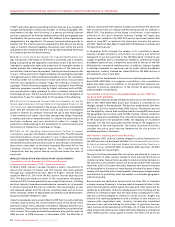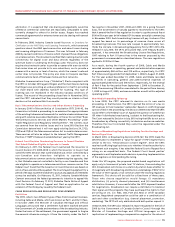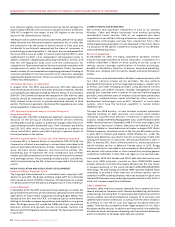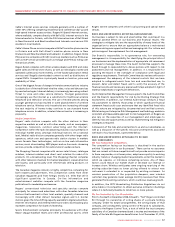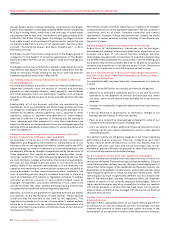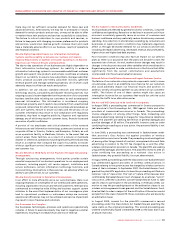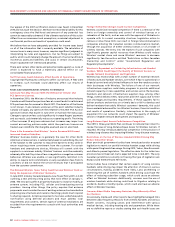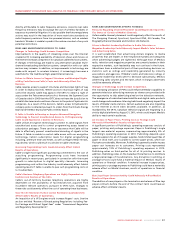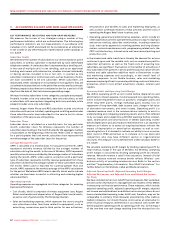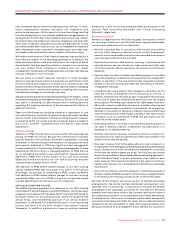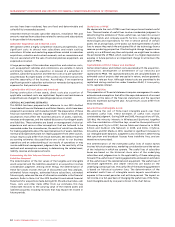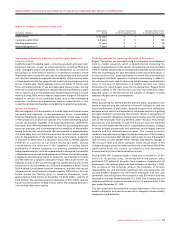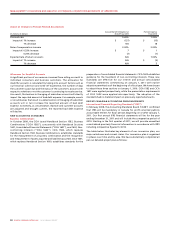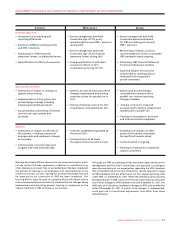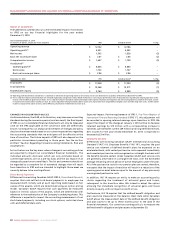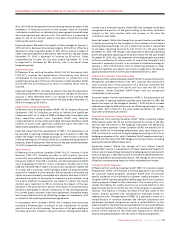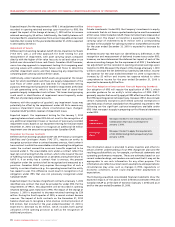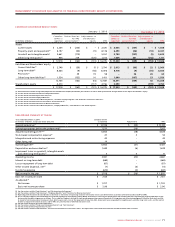Rogers 2010 Annual Report Download - page 57
Download and view the complete annual report
Please find page 57 of the 2010 Rogers annual report below. You can navigate through the pages in the report by either clicking on the pages listed below, or by using the keyword search tool below to find specific information within the annual report.
ROGERS COMMUNICATIONS INC. 2010 ANNUAL REPORT 61
MANAGEMENT’S DISCUSSION AND ANALYSIS OF FINANCIAL CONDITION AND RESULTS OF OPERATIONS
directly attributable to radio frequency emissions, concerns over radio
frequency emissions may discourage the use of wireless handsets or
expose us to potential litigation. It is also possible that future regulatory
actions may result in the imposition of more restrictive standards on
radio frequency emissions from low powered devices, such as wireless
handsets. Wireless is unable to predict the nature or extent of any such
potential restrictions.
RISKS AND UNCERTAINTIES SPECIFIC TO CABLE
Changes in Technology Could Increase Competition.
Improvements in the quality of streaming video over the Internet
coupled with increasing availability of television shows and movies on
the Internet increases competition to Canadian cable television systems.
If changes in technology are made to any alternative Canadian multi-
channel broadcasting distribution system, competition with our cable
services may increase. In addition, as improvements in technology are
made with respect to wireless Internet, it increasingly becomes a
substitute for the traditional high-speed Internet service.
Failure to Obtain Access to Support Structures and Municipal Rights
of Way Could Increase Cable’s Costs and Adversely Affect Our
Business.
Cable requires access to support structures and municipal rights of way
in order to deploy facilities. Where access to municipal rights of way
cannot be secured, Cable may apply to the CRTC to obtain a right of
access under the Telecommunications Act. However, the Supreme Court
of Canada ruled in 2003 that the CRTC does not have the jurisdiction to
establish the terms and conditions of access to the poles of hydroelectric
companies. As a result of this decision, Cable’s access to hydroelectric
company poles is obtained pursuant to orders from the Ontario Energy
Board and the New Brunswick Public Utilities Board.
If Cable is Unable to Develop or Acquire Advanced Encryption
Technology to Prevent Unauthorized Access to Its Programming,
Cable Could Experience a Decline in Revenues.
Cable utilizes encryption technology to protect its cable signals from
unauthorized access and to control programming access based on
subscription packages. There can be no assurance that Cable will be
able to effectively prevent unauthorized decoding of signals in the
future. If Cable is unable to control cable access with our encryption
technology, Cable’s subscription levels for digital programming
including, premium VOD and SVOD, as well as Rogers Retail rentals,
may decline, which could result in a decline in Cable’s revenues.
Increasing Programming Costs Could Adversely Affect Cable’s
Results of Operations.
Cable’s single most significant purchasing commitment is the cost of
acquiring programming. Programming costs have increased
significantly in recent years, particularly in connection with the recent
growth in subscriptions to digital specialty channels. Increasing
programming costs within the industry could adversely affect Cable’s
operating results if Cable is unable to pass such programming costs on
to its subscribers.
Cable’s Business Telephony Operations are Highly Dependent on
Facilities and Services of the ILECs.
Cable’s out-of-territory business telephony operations are highly
dependent on the availability of facilities/services acquired from
incumbent telecom operators, pursuant to CRTC rules. Changes to
these rules could severely affect the cost of operating these businesses.
Over-the-Air Television Station Licence Renewals Could Adversely
Affect Cable’s Results of Operations.
An imposition of a VFS regime would increase Rogers’ costs. See the
section entitled “Review of Broadcasting Regulations including Fee-
for-Carriage and Distant Signal Fees” under “Government Regulation
and Regulatory Developments”.
RISKS AND UNCERTAINTIES SPECIFIC TO MEDIA
Pressures Regarding Channel Placement Could Negatively Impact the
Tier Status of Certain of Media’s Channels.
Unfavourable channel placement could negatively affect the results of
The Shopping Channel, Sportsnet, Sportsnet ONE, G4 Canada, The
Biography Channel (Canada) and Outdoor Life Network.
A Loss in Media’s Leadership Position in Radio, Television or
Magazine Readership Could Adversely Impact Media’s Sales Volumes
and Advertising Rates.
It is well established that advertising dollars migrate to media
properties that are leaders in their respective markets and categories
when advertising budgets are tightened. Although most of Media’s
radio, television and magazine properties are currently leaders in their
respective markets, such leadership may not continue in the future.
Advertisers base a substantial part of their purchasing decisions on
statistics such as ratings and readership generated by industry
associations and agencies. If Media’s radio and television ratings or
magazine readership levels were to decrease substantially, Media’s
advertising sales volumes and the rates which it charges advertisers
could be adversely affected.
Changes in Technology Could Increase Competition.
The increasing utilization of PVRs could influence Media’s capability to
generate television advertising revenues as viewers are provided with
the opportunity to skip advertising aired on the television networks.
The emergence of subscriber-based satellite and digital radio products
could change radio audience listening habits and negatively impact the
results of Media’s radio stations. Certain audiences are also migrating
to the Internet as more video becomes available. In addition, as
mandated by the CRTC, Canadian television signals are migrating to a
strictly digital platform by August 31, 2011, which could impact Media’s
ability to reach certain audiences.
An Increase in Paper Prices, Printing Costs or Postage Could
Adversely Affect Media’s Results of Operations.
A significant portion of Publishing’s operating expenses consists of
paper, printing and postage expenses. Paper is Publishing’s single
largest raw material expense, representing approximately 8% of
Publishing’s operating expenses in 2010. Publishing depends upon
outside suppliers for all of its paper supplies, holds limited quantities of
paper in stock itself, and is unable to control paper prices, which can
fluctuate considerably. Moreover, Publishing is generally unable to pass
paper cost increases on to customers. Printing costs represented
approximately 13% of Publishing’s operating expenses in 2010.
Publishing relies on third parties for all of its printing services. In
addition, Publishing relies on the Canadian Postal Service to distribute
a large percentage of its publications. Any disruption in printing or
postage services could have a material impact on Media’s results of
operations or financial condition. A material increase in paper prices,
printing costs or postage expenses to Publishing could have a materially
adverse effect on Media’s business, results of operations or financial
condition.
Blue Jays Player Contract Activity Could Adversely Affect Media’s
Results of Operations.
The addition of new players or the termination and release of Blue Jays
player contracts before the end of the contract term could have an
adverse effect on Media’s results.





